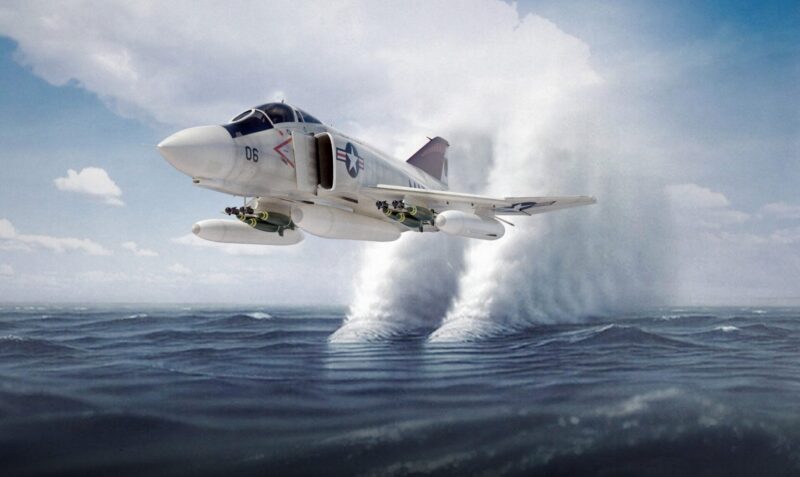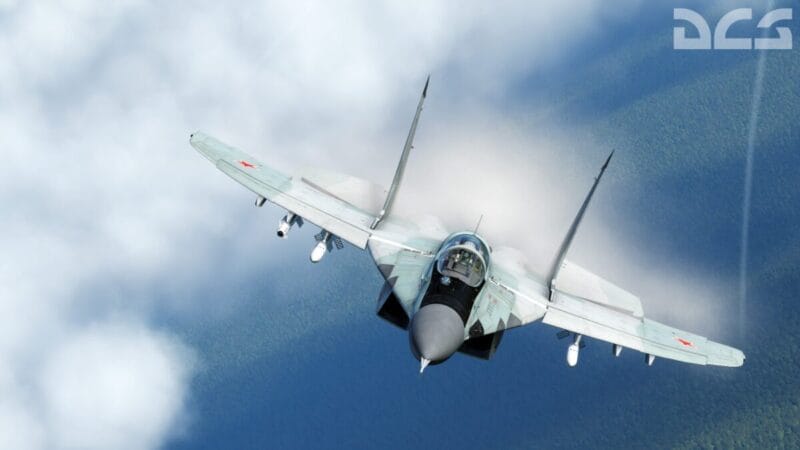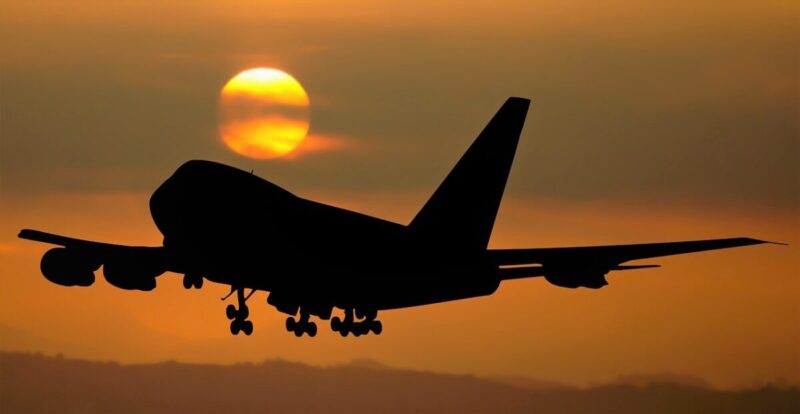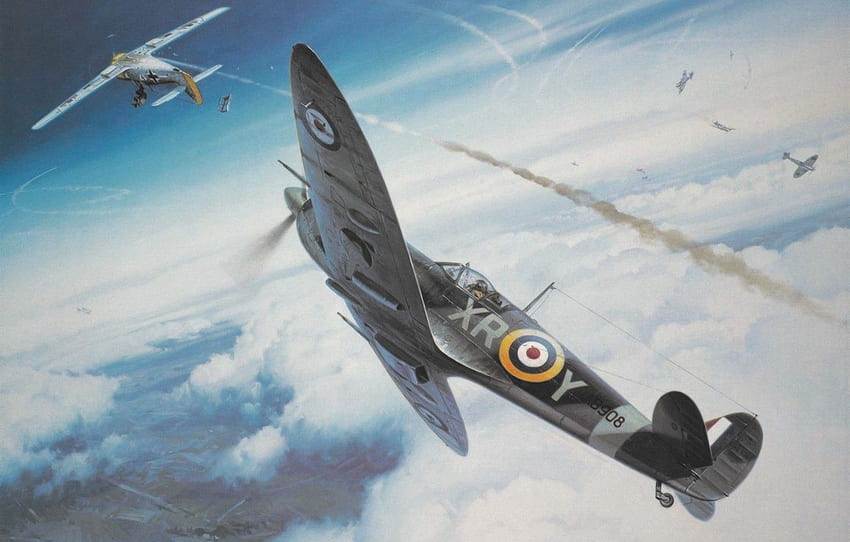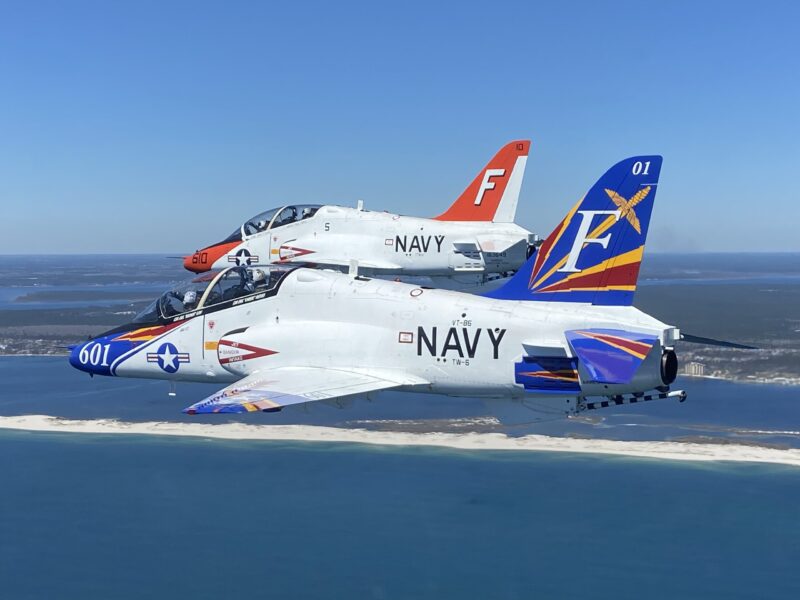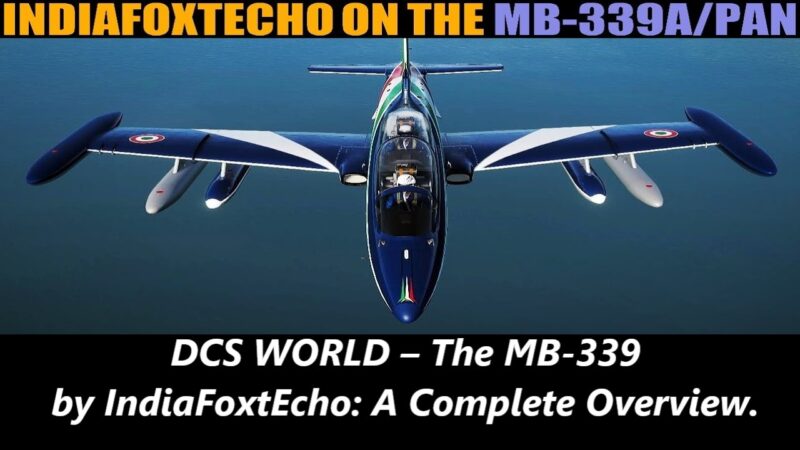DCS Cold War Aircraft What’s You need to Know Now!
Introduction
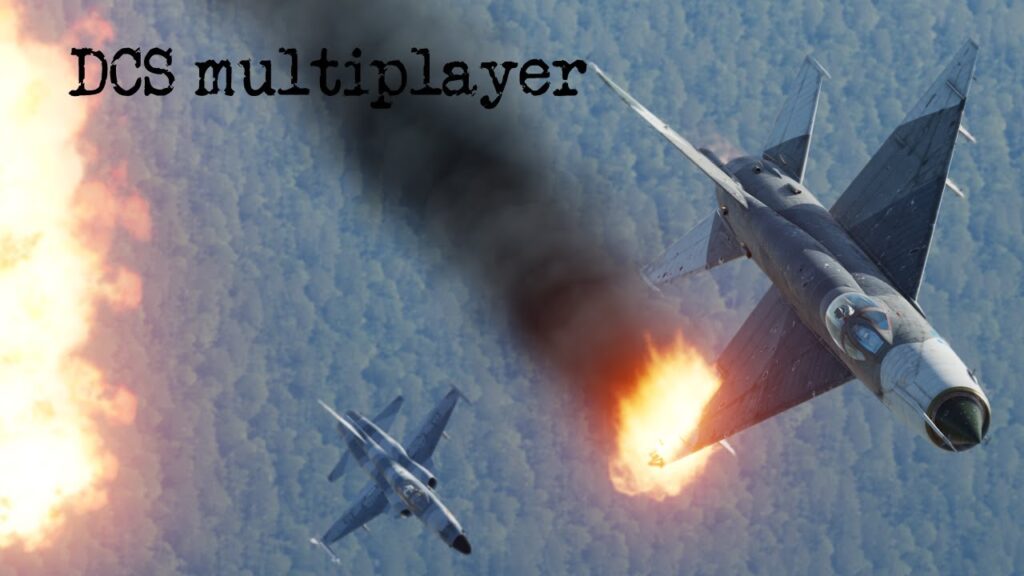
Basic Fighter Maneuvers (BFM) form the foundation of air combat, influencing the effectiveness of jet aircraft in dogfights. Within DCS World, Cold War-era jets possess unique aerodynamic characteristics that directly affect their combat performance. These jets require superior stick and rudder skills to excel where future jets will be computer assisted dreams.
In newer generation aircraft departures from controlled flight were difficult to achieve but this DCS cold war aircraft were easy to depart. It was about the feel of the jet and preventing departures which were somewhat common in the F-4 if mishandled.
The F-4 is renowned for departures at high AoA and rolling. It was discovered you should use the RUDDER to roll the aircraft if the stick was back in your stomach turning. Treat all these aircraft with respect because they will bite you!
We will Discuss the What – When- Where characteristics of these Cold War Aircraft.
This analysis evaluates the F-100 Super Sabre, A-6 Intruder, MiG-21bis, MiG-19P, MiG-23 MLA (Upcoming), F-4 Phantom II, and F-5E Tiger II in both historical and simulated engagements. This study examines each aircraft’s historical development, flight performance, optimal corner speeds, and effectiveness in one-circle and two-circle fights, using verified performance data.
Additionally, we compare DCS World flight models with real-world data, identifying areas where the simulation diverges from actual aircraft behavior. Further, this expanded assessment delves into operational roles, mission effectiveness, and real-world pilot perspectives, offering a comprehensive understanding of how these aircraft performed in service and how they are portrayed in digital combat simulations.
- Latest CPU’s Available Now – Amazon.com
- Get a NEW GPU Best Performance – AMAZON.com
- Upgrade RAM Here today – AMAZON.com
- Prebuilt PC Options – AMAZON.com
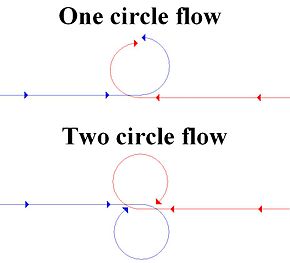
Understanding BFM: One-Circle vs. Two-Circle Fights
Basic Fighter Maneuvers (BFM) are the fundamental aerial combat techniques used to outmaneuver an opponent in a dogfight. The two primary types of maneuvering engagements are one-circle and two-circle fights, both referring to how aircraft turn relative to each other.
A one-circle fight occurs when both aircraft turn in the same direction after the merge, creating a single turning contest focused on nose position and instantaneous turn rate. This is ideal for fighters with high nose authority and strong high-alpha (angle of attack) performance, allowing them to pull lead and take a shot quickly.
In contrast, a two-circle fight happens when both aircraft turn in opposite directions post merge, maximizing the distance between their turn circles. This emphasizes sustained turn rate and energy retention, favoring aircraft that can maintain higher Gs overtime without excessive energy loss.
The breakdown of DCS Cold War Aircraft below will help you decide how you should aim to fly your aircraft of choice as well as know how your opponent is likely to fight. It’s great knowing your own jet down to every BOLD FACE PROCEDURE in your flight manuals but not knowing your enemy is like flying with your eyes closed! Learn all of them to be a great DCS WORLD combat pilot. Dive in and remember 🙂
Aerodynamic Performance Comparison (DCS World vs. Real World)
Below is a table categorizing Cold War aircraft preferences in BFM:
| Aircraft | Corner Speed (Knots) | Sustained Turn Rate (deg/sec) | Instantaneous Turn Rate (deg/sec) | DCS vs. Real-World Differences |
|---|---|---|---|---|
| F-100 Super Sabre | ~400-450 | 14-16 | 17-19 | Energy retention slightly exaggerated in DCS |
| A-6 Intruder | ~350-400 | 10-12 | 14-16 | Not designed for dogfighting |
| MiG-21bis | ~450-500 | 15-17 | 18-20 | DCS overestimates energy loss in turns |
| MiG-19P | ~400-450 | 17-19 | 20-22 | More responsive in DCS than real-world reports suggest |
| MiG-23MLA | ~430-480 | 13-15 | 16-18 | DCS model still in progress |
| F-4 Phantom II | ~420-470 | 12-14 | 15-17 | DCS slightly underestimates turn performance |
| F-5E Tiger II | ~350-400 | 18-20 | 21-23 | Flight model in DCS closely matches real-world data |
| Mirage F1 | ~390-440 | 14-16 | 18-20 | Slightly reduced energy retention in DCS |
One-Circle vs. Two-Circle Aircraft Preferences
The Energy Egg and Using the Vertical
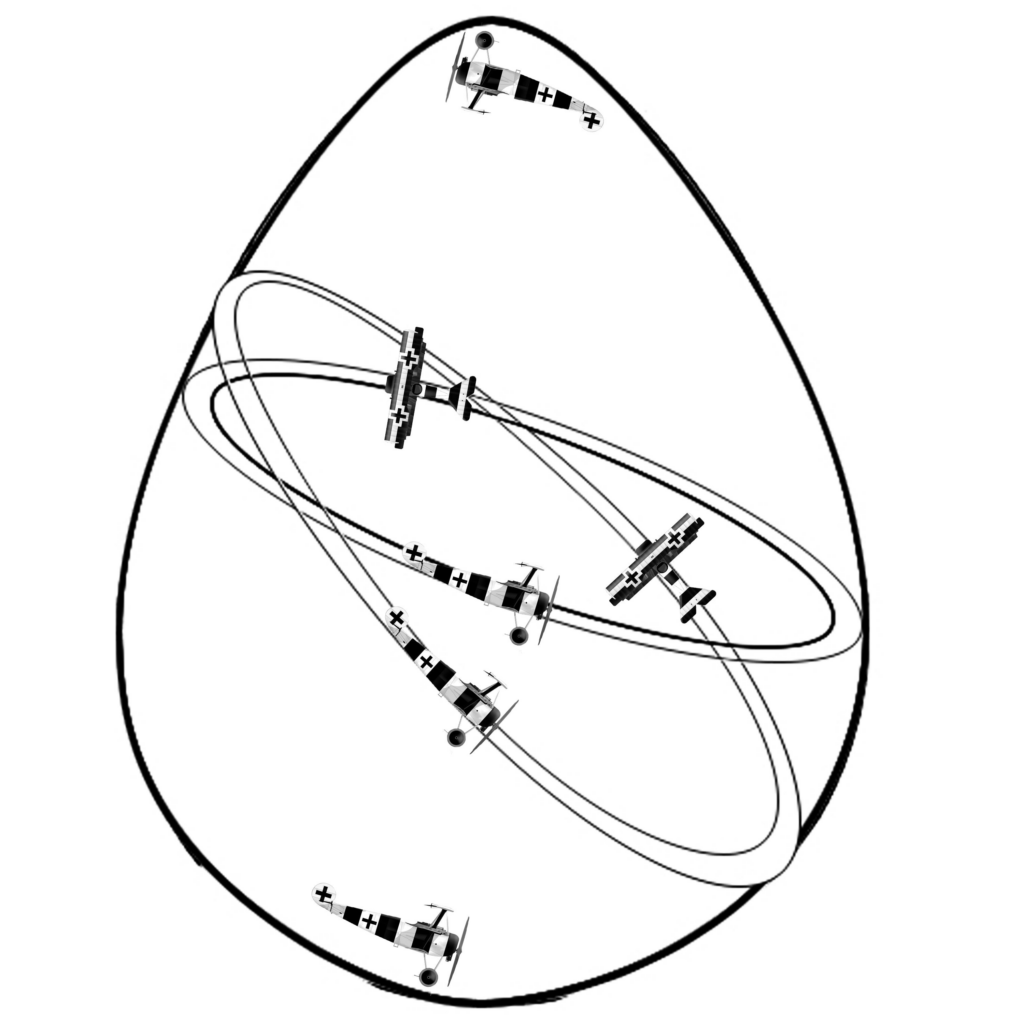
The Energy Egg is a conceptual model of an aircraft’s available energy and maneuvering capability in three dimensions. Imagine an egg-shaped volume around the aircraft where it can maneuver efficiently based on speed, altitude, and G-load. Fighters with high thrust-to-weight ratios, such as the F-4 Phantom II, MiG-21, and MiG-23, can use the vertical dimension to escape a low-energy state, reset the fight, or exploit their acceleration to out-climb opponents.
Instead of committing to a pure rate fight (two-circle) where their high drag would bleed energy quickly, they should use zoom climbs, rolling scissors, or high-speed yo-yos to force less powerful opponents into an inefficient state. This can be done by first knowing what speed your aircraft can enter a vertical climb and maintain it?
For example, the F-4 Phantom should avoid flat slow turns and instead use the vertical performance rolls or high G unloads to keep energy high while forcing bandits into an unfavorable angle. Similarly, the MIG-23, with its powerful engines but poor low speed turn rate, should use boom and zoom tactics making quick and aggressive passes before resetting in the vertical.
The MiG-21, while turn-capable, suffers from poor energy retention and should only commit to turns when necessary, using its excellent acceleration to regain lost energy before re-engaging.
1. Historical Context and Aircraft Design
F-100 Super Sabre (1954)
The F-100 Super Sabre was the USAF’s first fighter capable of sustained supersonic flight. Initially designed as an air superiority fighter, it later transitioned into a ground-attack role. The aircraft featured exceptional straight-line speed and energy retention but suffered from poor high-AoA maneuverability. Extensively used in Vietnam for close air support and limited air-to-air encounters, the F-100 became a crucial early Cold War jet.
Tactical Considerations
An F-100 Super Sabre pilot should exploit the aircraft’s high-speed maneuverability, strong roll rate, and energy retention while avoiding prolonged turning fights. The F-100 was designed as a fast, high-speed fighter-bomber, not a dedicated dogfighter, meaning it performs best in boom-and-zoom tactics rather than sustained turn engagements. Against more agile adversaries like the MiG-17 or MiG-19, the F-100 is at a disadvantage in a low-speed, one-circle fight but can use high-speed extensions and vertical maneuvers to reset the engagement.
Tips for F-100 Super Sabre Pilots:

- Avoid turning fights—the MiG-17 and MiG-19 will out-turn the F-100 in sustained engagements.
- Use speed to dictate the fight—engage with slashing attacks, then extend away before the enemy can counter.
- Leverage its roll rate—use rolling scissors to force overshoots when defensive.
- Go vertical when possible—zoom climbs can help escape slower-turning fighters.
- Pick your engagements wisely—against lower-speed opponents, energy management is key.
The F-100 Super Sabre is an energy fighter, excelling in high-speed slashing attacks and vertical maneuvering. To win, pilots must engage with speed, avoid slow speed turning fights, and use the aircraft’s roll rate and energy retention to maintain an advantage over more maneuverable adversaries.
A-6 Intruder (1963)
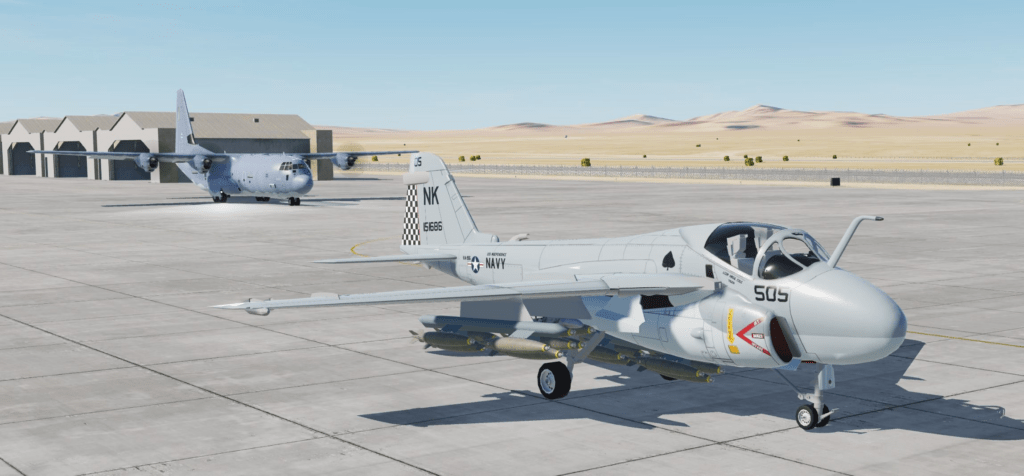
The A-6 Intruder was built as a highly effective all-weather attack aircraft rather than a dogfighter. Though not designed for air-to-air combat, it excelled in low-speed stability, high payload capacity, and advanced avionics for precision strikes. The inclusion of terrain-following radar allowed it to conduct deep-strike operations in adverse conditions, making it a vital part of U.S. Navy and Marine Corps operations.
Survival Tactic
The A-6 Intruder was never designed for air-to-air combat, as it was a dedicated all-weather attack aircraft with no built-in air-to-air radar or maneuverability suited for dogfighting. However, in a desperate situation, the A-6 could attempt to defend itself using its surprising power-to-weight ratio when lightly loaded, which gave it decent acceleration and a respectable climb rate. It also had good low-speed handling due to its large wing area, meaning it could potentially force an overshoot in a slow-speed fight.
That said, the best strategy for an A-6 pilot was always to escape rather than fight. With no air-to-air missiles (unless carrying Sidewinders in rare cases) and poor turn performance, it was extremely vulnerable against fighters like the MiG-17 or MiG-21. The best defensive options were diving away at high speed or using its terrain-following radar to fly low and evade enemy aircraft. If forced into a fight, an A-6 might try to force an overshoot at low speed or use its engine power to extend away, but any sustained engagement would almost certainly end in disaster.
MiG-21bis (1972)
The MiG-21bis represented the pinnacle of the MiG-21 lineage, emphasizing high-speed interception, superior climb rates, and rapid acceleration. However, its delta-wing configuration resulted in a trade-off: excellent instantaneous turn performance but poor sustained turn capability. Limited fuel reserves and basic avionics required pilots to engage decisively, making the MiG-21bis a challenging but rewarding aircraft to master.
Employing the Mig-21 Tactically
A MiG-21 pilot should leverage the aircraft’s small size, high acceleration, and climb rate to engage and disengage on their terms. It excels in hit-and-run tactics, not prolonged turning fights. Against F-4 Phantoms or F-105s, use hit-and-run slashing attacks and zoom climbs to force them into an energy-depleting chase. Against more maneuverable opponents like the F-5E or F-16A, avoid one-circle fights and instead extend, reset, and re-engage from an advantageous position.
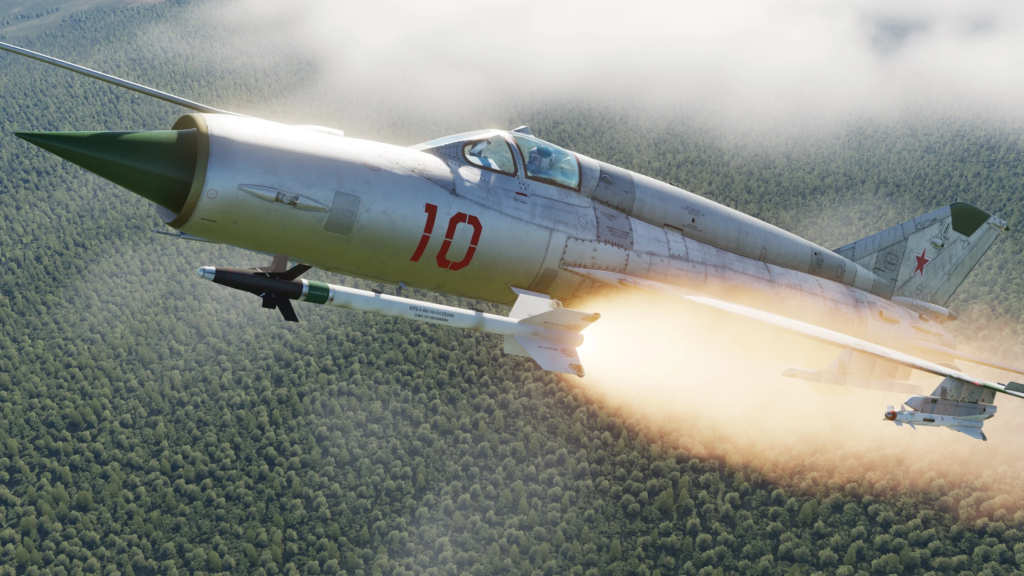
Tips for MiG-21 Pilots:
- Use speed and vertical maneuvers—climb aggressively after an attack to reset the fight.
- Avoid slow-speed turning battles—most Western fighters have better nose authority and sustained turn rates.
- Ambush from high or low angles—strike fast, fire missiles or guns, then disengage.
- Use terrain for evasion—drop low to break radar locks and force opponents into risky engagements.
- Engage in short bursts—long, drawn-out dogfights favor the more maneuverable Western jets.
In summary, the MiG-21 is a fast, ambush predator—strike first, strike fast, and escape before the enemy can turn the fight against you.
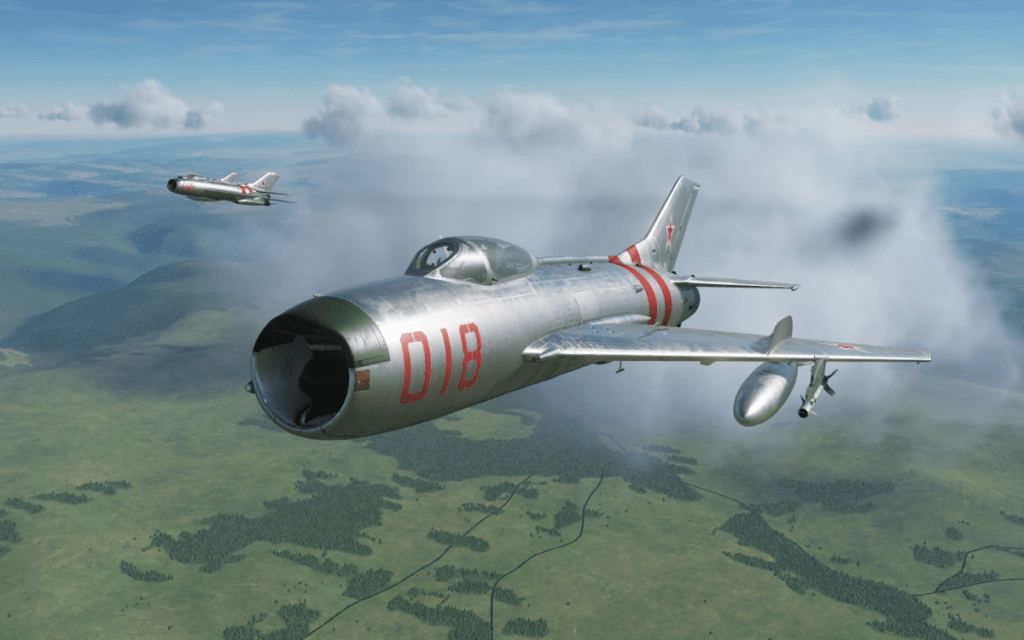
MiG-19P (1955)
The MiG-19P was one of the first Soviet supersonic fighters, boasting twin engines, impressive acceleration, and commendable sustained turn performance. However, it suffered from high fuel consumption and rudimentary avionics. Though it saw limited combat, the MiG-19 served as a steppingstone to more advanced Soviet fighter designs, including the MiG-21 and MiG-23.
Tactical Employment
A MiG-19P pilot should take advantage of the aircraft’s strong climb rate, high-speed maneuverability, and twin-engine thrust to dictate engagements. The MiG-19P has a better turn rate than the MiG-21, making it more viable in one-circle fights against heavier opponents like the F-4 Phantom or F-105. However, it still lacks the high-angle-of-attack (AoA) control of Western fighters like the F-8 Crusader or F-5E, so prolonged turning fights can be risky.
Tips for MiG-19P Pilots:
- Use vertical maneuvering—climb aggressively after attacking to maintain energy dominance.
- Capitalize on high-speed turns—it has better instantaneous turn rate than the MiG-21, useful for quick nose-on shots.
- Avoid slow-speed, sustained fights—the MiG-19 bleeds energy fast in prolonged turns.
- Boom-and-zoom against heavier jets—hit Phantoms or Thunderchief’s with quick bursts, then extend away.
- Use gun-focused engagements—the MiG-19P’s twin 30mm cannons are lethal at close range, so forcing an overshoot can be effective.
Overall, the MiG-19P is an aggressive interceptor that thrives on high-speed attacks and short, decisive engagements. Use its climb rate and firepower to strike hard and escape before the enemy can exploit its energy bleed.
MiG-23MLA (Upcoming) (1978)
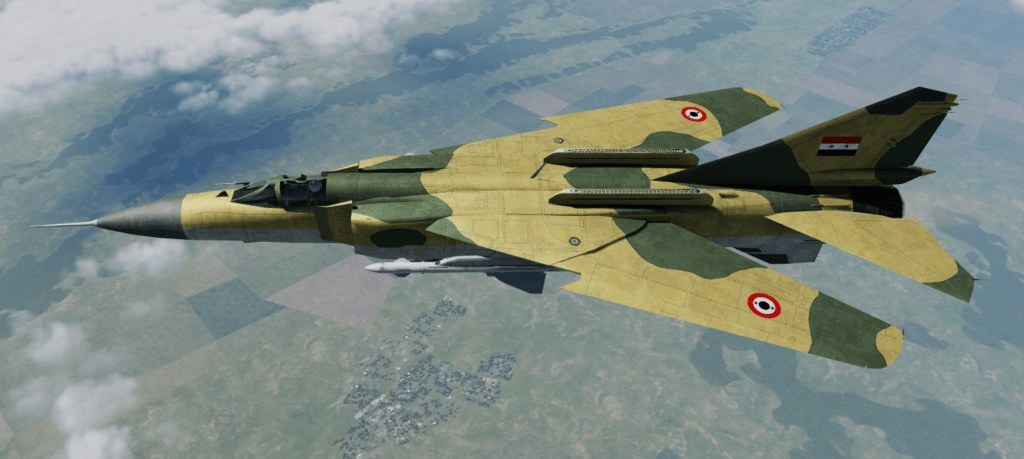
The MiG-23MLA introduced variable-geometry wings, optimizing performance across a range of speeds. While it excelled in BVR (Beyond Visual Range) engagements, its close-quarters dog fighting capability was inferior to its Western counterparts. The MiG-23 was widely exported and saw action in numerous conflicts, proving effective in some engagements but suffering from handling limitations in WVR (Within Visual Range) scenarios.
Survival is Power
A MiG-23MLA pilot should exploit the aircraft’s superior speed, acceleration, and energy retention to engage and disengage at will. Unlike earlier MiGs, the MLA variant has a powerful radar and better avionics, allowing for beyond-visual-range (BVR) missile shots before committing to a dogfight. However, the MiG-23 is not a turn fighter—its high wing loading and poor sustained turn rate make it vulnerable in prolonged engagements against agile opponents like the F-16A or F-5E.
Tips for MiG-23MLA Pilots:
- Engage at BVR when possible—use R-23 or R-60 missiles to strike before merging.
- Use speed and vertical extensions—zoom climb after an attack to reset and avoid turning engagements.
- Avoid one-circle fights—Western fighters have superior nose authority and can easily out-turn the MiG-23.
- Boom-and-zoom against Phantoms and Eagles—exploit acceleration and high-speed missile shots.
- Defensive strategy: Extend, don’t turn—if at a disadvantage, use afterburner and dive away rather than trying to out-turn an opponent.
The MiG-23MLA is a fast, hard-hitting interceptor, not a dogfighter. To win, control the fight through speed, missile range, and vertical maneuvering, avoiding slow-speed engagements at all costs.
F-4 Phantom II (1958)
The F-4 Phantom II was a dominant multi-role fighter, known for its high acceleration, superb dive speed, and formidable armament. However, it was hindered by poor sustained turn rates and sluggish high-speed maneuverability. Despite these shortcomings, the F-4 was a staple of air combat throughout the Cold War, excelling in BVR combat thanks to its powerful radar and missile systems.

Driving the Beast
An F-4 Phantom II pilot should maximize the aircraft’s speed, power, and vertical maneuvering while avoiding prolonged turning engagements. The Phantom has excellent acceleration, high-speed maneuverability, and powerful radar-guided missiles, making it most effective in BVR or hit-and-run tactics. However, it suffers from poor instantaneous turn rate, high energy bleed in sustained turns, and no gun (early variants), making it vulnerable to smaller, more agile fighters like the MiG-17, MiG-19, and MiG-21 in a dogfight.
Tips for F-4 Phantom II Pilots:
- Engage at BVR when possible—use AIM-7 Sparrows to strike before merging.
- Use the vertical—zoom climbs, high yo-yos, and vertical displacement rolls help maintain energy.
- Avoid low-speed fights—the F-4 has poor turn performance; don’t get dragged into a one-circle fight.
- Boom-and-zoom tactics—high-speed slashing attacks are the safest way to engage MiGs.
- Use teamwork—Phantoms performed best in multi-aircraft tactics, such as dragging enemy fighters into an AIM-7 kill zone.
The F-4 Phantom is a fast, powerful fighter-bomber that thrives in high-speed, vertical, and missile-driven engagements. To win, Phantom pilots must dictate the fight’s terms, use their speed to extend, and avoid slow-speed turning battles at all costs.
F-5E Tiger II (1972)
The F-5E Tiger II was an agile, lightweight fighter prized for its exceptional turn rate, outstanding visibility, and small radar cross-section. Though it lacked sophisticated avionics, its manual flight controls and responsive handling made it a lethal platform in WVR combat. The F-5 was widely exported and performed effectively in air policing and limited engagements worldwide.
I find this personally a pleasing jet to fly and much more demanding of the pilot to get the most out of this little skyrocket. The danger in BFM is over G and tearing the wings off! Done this to many times when already in a great position. Learning to use stick and rudder in a coordinated manner will ensure flying in all of these jets is the most fun.

Surprisingly Nimble
An F-5 Tiger II pilot should take advantage of the aircraft’s superb agility, high sustained turn rate, and small visual and radar cross-section to outmaneuver opponents in a dogfight. Unlike the F-4 Phantom, the F-5 thrives in close-range, maneuvering engagements, particularly two-circle fights, where its excellent sustained turn rate allows it to out-turn heavier or less efficient adversaries like the MiG-21 and MiG-23.
However, the F-5 lacks BVR capability, has low thrust-to-weight ratio, and struggles in high-speed vertical fights, making it vulnerable against high-energy opponents like the MiG-23MLA and F-4 Phantom. You need to be diligent on your RWR to know your being hunted.
Tips for F-5 Tiger II Pilots:
- Force a two-circle fight—maximize the F-5’s strong sustained turn rate against faster but less agile adversaries.
- Stay inside the enemy’s turn—against MiG-21s or MiG-23s, out-rate them in a prolonged turn fight.
- Avoid vertical extensions—jets like the MiG-23 and F-4 have better acceleration and can escape or reposition.
- Use low-speed agility—the F-5 remains maneuverable at lower speeds, useful for forcing overshoots.
- Stay unpredictable—against BVR-capable opponents, use terrain and low-altitude maneuvering to close the distance.
- RETAIN ENERGY & Maintain your ability to turn!
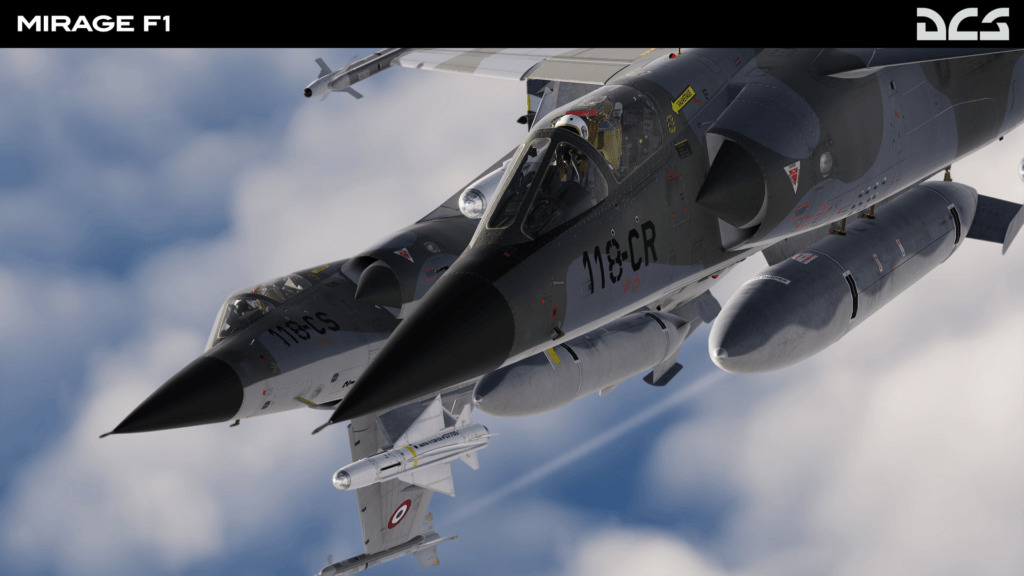
The F-5 Tiger II is a nimble, close-range dogfighter that thrives in sustained turn fights and low-speed maneuvering. To win, F-5 pilots must drag opponents into a turning engagement, stay inside their adversary’s turn radius, and avoid high-speed vertical fights where energy advantages shift to heavier, faster aircraft.
Mirage F-1
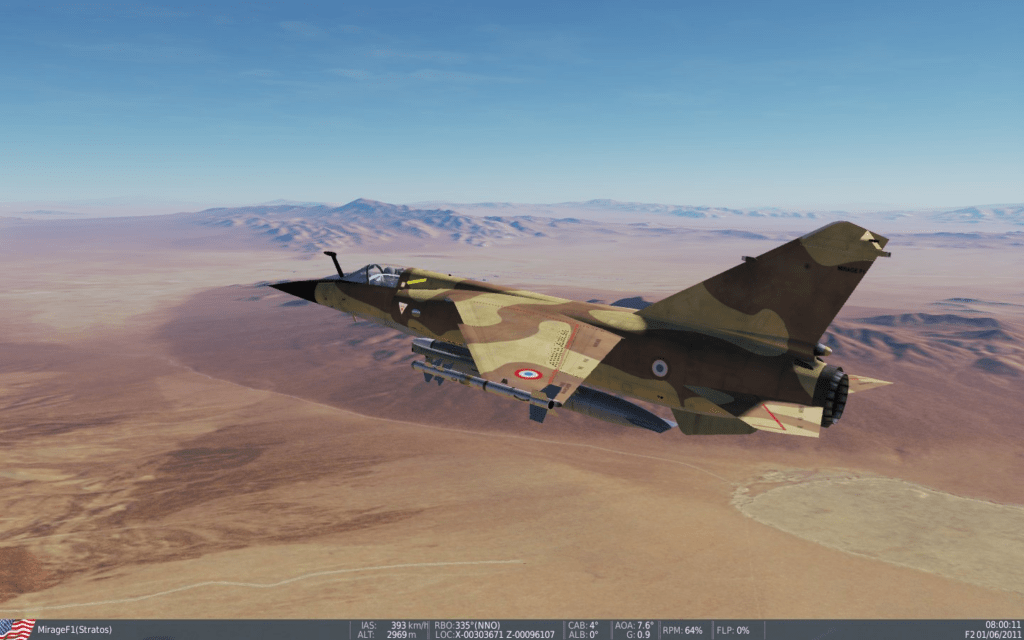
The Mirage F1 is a versatile Cold War-era fighter designed primarily for interception and multi-role capabilities. Unlike its delta-wing counterparts, such as the Mirage III, the F1 features a conventional swept-wing design, which improves energy retention and maneuverability at higher speeds. Equipped with a powerful Snecma Atar 9K-50 engine, it offers solid acceleration and good sustained turn performance, making it well-suited for high-speed engagements and energy-based fighting. While it lacks the high-AoA handling of some competitors, it compensates with superior boom-and-zoom potential and high-speed control authority.
Mirage F1 Overview and Combat Strategy
- Force a two-circle fight—the Mirage F1’s strong energy retention allows it to excel in sustained turn fights over prolonged engagements.
- Avoid low-speed turning engagements—jets like the MiG-19P and F-5E can out-turn the Mirage F1 at lower speeds.
- Leverage boom-and-zoom tactics—maintain speed and use the Mirage F1’s acceleration to engage and disengage on your terms.
- Use vertical maneuvers effectively—while not the best in high-AoA situations, the Mirage F1 can utilize energy to dominate in vertical extensions.
- Manage fuel carefully—the Mirage F1’s fuel consumption can be high in afterburner, so plan engagements accordingly to avoid running out of energy mid-fight.
- Joystick / HOTAS – AMAZON.com
- Rudder Pedals – AMAZON.com
- Throttle Quadrant – AMAZON.com
- Gaming Chair – AMAZON.com
- VR Headset – AMAZON.com
Aerodynamic Performance Comparison (DCS World vs. Real World)
| Aircraft | Corner Speed (Knots) | Sustained Turn Rate (deg/sec) | Instantaneous Turn Rate (deg/sec) | DCS vs. Real-World Differences |
|---|---|---|---|---|
| F-100 Super Sabre | ~400-450 | 14-16 | 17-19 | Energy retention slightly exaggerated in DCS |
| A-6 Intruder | ~350-400 | 10-12 | 14-16 | Not designed for dogfighting |
| MiG-21bis | ~450-500 | 15-17 | 18-20 | DCS overestimates energy loss in turns |
| MiG-19P | ~400-450 | 17-19 | 20-22 | More responsive in DCS than real-world reports suggest |
| MiG-23MLA | ~430-480 | 13-15 | 16-18 | DCS model still in progress |
| F-4 Phantom II | ~420-470 | 12-14 | 15-17 | DCS slightly underestimates turn performance |
| F-5E Tiger II | ~350-400 | 18-20 | 21-23 | Flight model in DCS closely matches real-world data |
| Mirage F1 | ~390-440 | 14-16 | 18-20 | Slightly reduced energy retention in DCS |
Tactical BFM Approaches
Each aircraft demands a tailored tactical approach:
- F-100 Super Sabre: Energy fighter; excels in high-speed combat.
- A-6 Intruder: Not suited for dogfighting; prioritizes evasive maneuvering.
- MiG-21bis: Boom-and-zoom specialist; suffers in prolonged turning engagements.
- MiG-19P: Superior sustained turn rate but lacks modern avionics.
- MiG-23MLA: Optimized for BVR; underperforms in WVR combat.
- F-4 Phantom II: Leverages speed and firepower; avoids sustained engagements.
- F-5E Tiger II: Ideal for WVR engagements; thrives in turn-based combat.
- Mirage F1: Versatile but energy-dependent; excels in high-speed intercepts.
4. Conclusion
DCS Cold War-era jets provide an immersive simulation experience, but a clear understanding of real-world vs. simulated performance is crucial for mastering engagements. The MiG-23MLA, once released, will further expand the roster with another variable-geometry aircraft, adding diversity to DCS’s tactical landscape. These aircraft played pivotal roles in Cold War aviation, and their accurate representation in DCS allows virtual pilots to explore their strengths and limitations in depth.
With this information you can now better plan your tactics to maximize your aircraft performance and understand likely opponents game plan options so as to win the battle!
Which Cold War jet do you think is the best representation in DCS? Share your thoughts in the comments!
Author
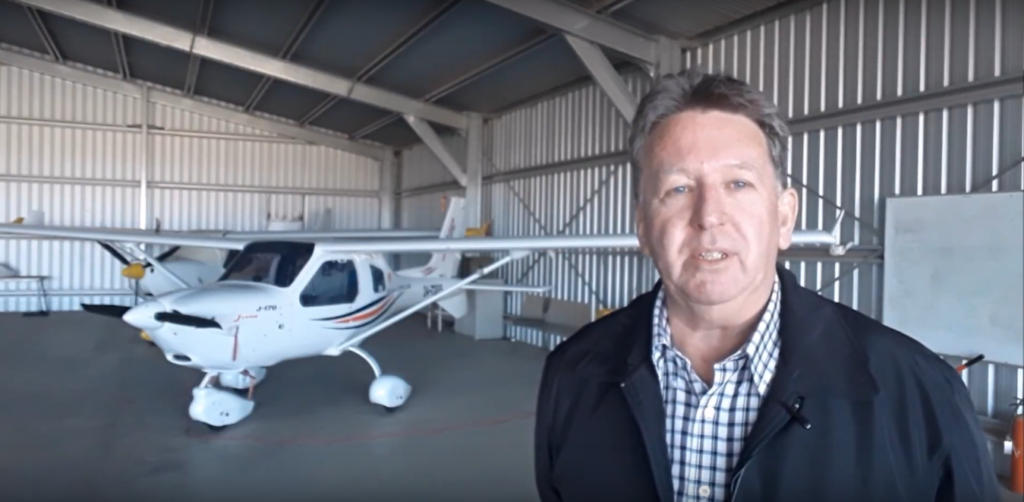
Brendon McAliece (Aka Gunnie) is a military veteran with 23 years working on Jet Fighters, their weapons systems and ejection seat/module systems as well as munitions and R&D. Involved with flight simulation since the 1980s, he has flown all the major flight simulators over the years.
He is an Australian expat who has lived in Malaysia, UK, Saudi Arabia and more recently Thailand. He is a multi-lingual blogger who loves to share his life experiences here on LetsFlyVFR.com and DreamingGuitar.com, with his lifestyle and Travel experiences Blog plus his Dreaming Coffee website.
Learn More @
DreamingGuitar.com – DreamingCoffee.com – LetsFlyVFR.com
( HOME – BLOG – SHOP – ABOUT )
As an Amazon affiliate I may benefit from qualifying sales.
